#liber de natura rerum
Explore tagged Tumblr posts
Text
Hey tumblr we need to have a talk about something I noticed.
Specifically going by tags attached to images I’ve blogged or reblogged, there seems to be a misconception that marginalia means “any quirky medieval art”.
It’s not.
Marginalia is anything in the margins of a text.
The ones that will get posted on tumblr will more often than not be quirky drawings, but they also include notes, annotations, scribbles, and whatever else. The quirky drawings just happen to get a lot of press on here because, well. They’re quirky drawings.
For instance, see this image here of a platanista (river dolphin) chomping down on an elephant’s trunk?
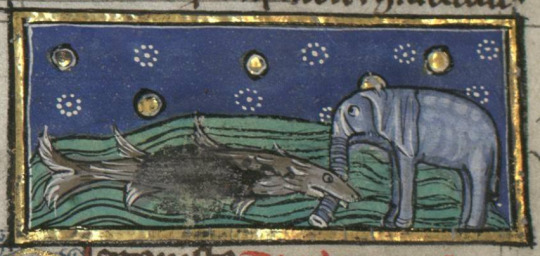
This is not marginalia! This is a full-fledged illustration. It’s within the text (Liber natura rerum, Thomas de Cantimpré, Librairie de Valenciennes Ms 0320). It illustrates the entry on Platanista.
This is what it looks like in context.
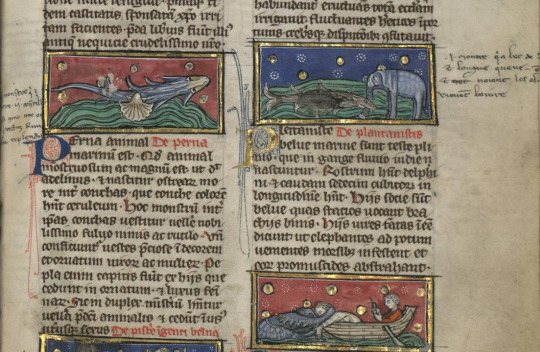
But you know what are marginalia? Let me circle them for convenience.
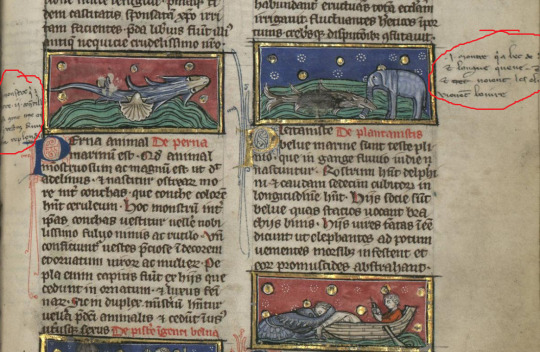
Know the difference. It won’t save your life but it will make you more popular at a medievalist conference.
4K notes
·
View notes
Text






aquatic creatures (stella, zytiron, serra marina, equus marinus, monachus, scilla)
illustrations from a manuscript copy of thomas of cantimpré's 13th c. liber de natura rerum, bavaria, c. 1424
source: Vatican, Bibl. Apostolica Vaticana, Pal. lat. 1066, fol. 110r-125v
#15th century#thomas of cantimpré#de natura rerum#liber de natura rerum#hybrids#stella#zytiron#serra marina#equus marinus#monachus#scilla#medieval art
1K notes
·
View notes
Note
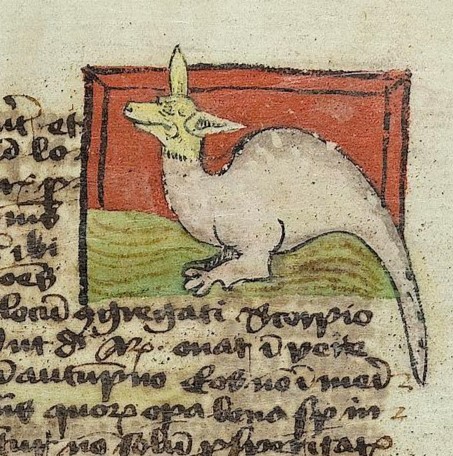
scorpion in thomas of cantimpré's 'liber de natura rerum', bavaria, c. 1424. Vatican, Biblioteca Apostolica Vaticana, Pal. lat. 1066, fol. 132v
[Image ID: A bipedal creature with a grayish body and a tail. It kind of looks like a chicken in silhouette, but with tail and feet like a lizard. Its head is yellow rather than gray, and looks vaguely canine. At least if you had a dog who was bald, wrinkly, yellow, 100 years old, and in a bad mood about it.]
This is so extremely not a scorpion. If there hadn't been a couple of critters with this body plan in the original post, I would be completely floored by this one's existence. Even so, I'm still just kind of staring at it in confusion.
Like, let's be clear here, this is not what Mr. Of Cantimpre is describing in the text. He includes such items as:
A scorpion is a serpent, as Solinus says, which is said to have a charming and virgin-like face.
But it certainly has a poisonous sting in its knotted tail, with which it stings and infects any that approach it.
The scorpion is the only insect that has a tail, and arms, and a spike in the tail.
(I found a translation this time instead of fighting with the Latin -- this is from https://bestiary.ca/ . They admit that this is a machine translation with a human editor, so grain of salt, though.)
None of this is represented in the illustration. Like, Tommy Boy up there can't seem to decide whether this is a serpent or an insect (I'm going to assume the overly-flexible term worm is at fault in this case), but the animal pictured seems to be neither. Its tail is neither knotted nor spiked. You could maybe argue that those are arms. Not on board with the illustrator's interpretation of "charming and virgin-like face"... okay, I guess it's kind of ugly-cute, but that's a stretch.
Anyhow, points:
Small Scuttling Beaſtie? scale unclear, not enough legs, ✘
Pincers? ✘
Exoskeleton or Shell? ✘
Visible Stinger? ✘
Limbs? 2
Vibes... eh. It has charming aspects, but it has this bad-tempered expression on a face that I'm not sure how to react to. 3/5.
Total:
3.2 / 10
I have questions about the illustrator's tastes.
68 notes
·
View notes
Text
Creativity Update
Lately there's been an endless drive to cast on many projects that feed my creativity. I have a list or 'to swatch' which but the main priority is to swatch the Iris Sweater by Trin-Annelie, first.
I put in a mass order with Knitting for Olive during their holiday sale...
This meant I could pick up some sweater quantities for a navy sweater and a cream/off-white sweater (pattern to be picked). I also went through and planned for the colours for the Iris. Notably, the pattern is designed for Holst Supersoft (which I have worked with previously, see my project page on Ravelry for the Felix Cardigan) - and the packs/kits when the Iris was released, sold out immediately. Which is great, but also not so great for anyone who missed out. Holst is a work-horse yarn, meaning, you can hold multiple strands, and it blooms beautifully, AND because it's essentially untreated (still with spinning oil in it) - you get a rustic but durable garment which isn't meant to 'pill' as quickly with wear. Important for the high-friction areas and what it means for mending. This meant I was exploring other alternatives and ended up with Knitting For Olive. I already knew it was going to be a time investment for a light fingering weight colourwork sweater... so I figured, why not opt for something which is on sale, and they have similar muted colours in similar chroma which could work. End result, a very large order to continue to inspire my creativity as my self-made wardrobe grows (slowly).
Side note: Admittedly, at times my collection of creativity (read: stash) - grows and evolves at a faster rate than I can knit, but I remind myself that this is my source of creativity. I am trying to be a bit more unapologetic about what brings me joy.
The Iris
This expansion of my source of creativity, means I have two options to explore for the Iris.
Option A: Per the Pattern

Image source and credit: © Trin-Annelie
Or Option B - which is the green template I mocked up, on the left - which is side by side to the mock-up of the Knitting For Olive 'blues' on the left.

I'm still deciding on the main colour for the body, I'm between Marzipan and Cream. This planning stage of something complex is something I'm really enticed about and really motivated. I feel very inspired and even considered knitting each flower with an alternating blue/green.
I've told myself, once I finish my current WIPs which includes a test knit for Vert & Rose Knitting. I also have two Paul Klee Sweaters by Midori House, which I've made up for my niece and nephew; and a Traveller's Shawl using handspun which I'm hoping to all have done by March. The Shawl especially as it's due to the recipient mid March.
The Twigs
I have the beginnings of The Twigs by Junko Okamoto on the needles as I couldn't resist breaking into the Ulysses yarn by De Rerum Natura. It's crispy and delightful to the touch. I'm done with the awesome cast-on to start the collar and I've put it to the side for the moment, as I've told myself to finish my Badger Sweater first. No, not the 'Badger' that's popularly known, rather the Badger that's in the book 'Observations' by Lotta H Lothgren.
Sewing
Meanwhile, I'm waiting for the printed sewing pattern of the Chanterelle Pants to arrive so I can start the Sew Liberated course for pants fitting. My biggest creativity goal is to learn to sew my own pants. I have been wanting to move away from buying new garments from the store.

Image Credit: Sew Liberated
I have really wanted to be self sufficient when it comes to textiles and clothing. It's why I work to evolve my knowledge, and have learnt to spin, knitting and sew. I have entertained the idea of weaving even though previously, I didn't necessarily feel drawn to it.
Weaving
I have been connecting a lot with my history and cultural roots, which originate from South America. This has taken the form of listening to stories of artisans from the Patagonia, who share how they learnt to weave, embroider, knit and also spin. These interviews are beautiful retellings of family histories and connection to land and self-sufficiency. Stories which display learning crafts out of necessity before then turning it into a means to earn income in arid landscapes amongst warm communities.
The episodes are entirely in Spanish and so if you speak or understand Spanish, you will most definitely enjoy the richness this pod has to offer.
For those who are curious - Atlas Textil produced by Pulso Austral is available on Spotify.
So TBA on whether I embark on learning to weave, but for the moment I am learning a lot about ancestors of the lands from which I originate and this is doing so much to fill my creativity cup.
Until next time!
8 notes
·
View notes
Text











succession and the worm
Succession (HBO) // Koninklijke Bibliotheek // Liber de natura rerum // Hamlet // 'The Lambton Worm' // Chrysopoea of Cleopatra // Wikipedia
187 notes
·
View notes
Text
Praise to Venus Physica
"MOTHER of the Aeneadae, darling of men and gods, increase-giving Venus, who beneath the gliding signs of heaven fillest with thy presence the ship-carrying sea, the corn-bearing lands, since through thee every kind of living things is conceived, rises up and beholds the light of the sun."
- Lucretius, De Rerum Natura, Book I
(and a pic of Venus taken by me ;))
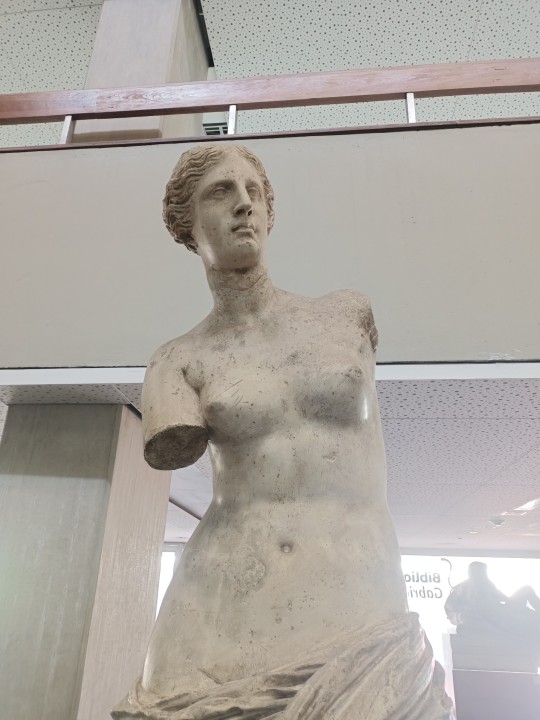
#epicurean#epicureanism#epicurean theology#epicurus#lucretius#de rerum natura#greek philosophy#roman philosophy#venus#goddess venus#venus goddess#goddess#deity devotion#roman mythology#religious art#religio romana
6 notes
·
View notes
Text
𝐀𝐦𝐨𝐫, 𝐩𝐞𝐫𝐢𝐜𝐮𝐥𝐨𝐬𝐚 𝐩𝐚𝐬𝐬𝐢𝐨
1075 "[...] Nam certe purast sanis magis inde voluptas
quam miseris. Etenim potiundi tempore in ipso
fluctuant incertis erroribus ardor amantum
nec constat quid primum oculis manibusque fruantur.
Quod periere, premunt arte faciuntque dolorem
1080 corporis et dentis inlidunt saepe labellis
osculaque adfligunt, quia non est pura voluptas
et stimuli subsunt qui instigant laedere id ipsum
quodcumque est, rabies unde illaec germina surgunt.
Sed levior poenas frangit Venus inter amorem
1085 blandaque refrenat morsus admixta voluptas."
...
1075 "[...] Voluptuousness is more clear to the wise than to the foolish wretches.
In fact, right at the moment of full possession,
the ardor of lovers fluctuates in uncertain waves
who do not know what to first enjoy with their eyes and hands.
They press tight the creature they desire, inflict pain
1080 to her body, and often bite the tender lips to blood,
they nail her with kisses, for pleasure is not pure,
and there are dark impulses that push to tear the object,
whatever it is, from which the germs of that fury arise.
It hardly attenuates the torment Venus in the act of love,
1085 mitigates the bite, to which it is mixed, the joy of the senses."
Titus Lucretius Carus, vv. 1075-1085, De Rerum Natura IV liber.

#yandere#yandere core#tw: yandere#Latin#ancient rome#lucretius#yandere love#love#yandere anime#yandere x reader#litterature#roman literature
8 notes
·
View notes
Text
Pre-prosa literaria prosa preletteraria:
tr. omne verbum dicitur ad hoc, gentes repetunt. communi voluntate.
Scimus in prisca aetate inter prosam et poesin plane distingui non posse, idcirco ad proprias prosas illas productiones considerandas, quae postea in soluta oratione, i.e. orationes, annales, fasti, laudationes funebres, in quibus multae notae primae oratoriae et historicae distingui possunt.
Commentarii e fasti In exercitio sui mandati politici, unicuique
Magistratu Romano negotium erat notare gravissimas eius magistratus. Notae hae originaliter naturam privatam habebant et in archivo familiae conservabantur. Postmodum publica cura, et praesertim ea quae ad collegia sacerdotalia pertinebant, a religiosis ducibus in praetorio officiali servabantur. Principio documenta haec nomen commentarii vel librorum indifferentem habuerunt, tum terminus commentarius pressius rerum gestarum memoriam designavit, dum liber normarum ritualis naturae, protocolla et statuta indicabat. Romani historici annalesque per centurias traxerunt ut res gestas in opere suo referrent, ex quibus fasti consulares appellati sunt. Hae tabulae, quae Fasti Capitolini notae sunt, ad nos pervenerunt in forma epigraphica et hodie in Campidoglio servantur. Iuxta ea quae a fontibus historicis tradita sunt, Summi Pontificis munus sunt in archivo civitatis conservandi et adaequationis officialis.
commentaria seu libri
gloria
Omnes ad familias patricias pertinentes, Romani Pontifices, in antiquissima historiae Romanae parte, statuta et praecepta de Civitatis operatione viva voce tradiderunt, constituentes vinculum inter politicam et religiosam potestatem, quae diu in historia Romana duravit. Fasti, qui fasti, sic dicti, componendis mandabantur, in quibus dies fasti, i.e. dies, quibus ius administrari poterat, rei publicae, militaris, et religiose observabant.
Calendarii romani instaurationem.
AUAN EFFER MAR
NASEX DE SEP FEROCINE NOV PRO DECNCEINTER
hn
CC HC
A.D
AN-
A.D
ENON F NON FACIENDUM OM CHON
DF extensionis
EC
UNUM BON
DN
ACON E
LEMVRNEN
GC
DN
EMIN
VESTON
en
CITREA MARN
EMEDIC
ON
FONT DC extensio
SN
en
CFORORDER
EC
HEN'
HC
ET CONTINET
YPER 20
FC
gn extensione
AGONN
FLVC extensionem
en
WALF
ET
DIERMIN CC
EREGIN
ALOBIGN HO
ECERECH
FC
JAN
HEQUIR
CEN
0 notes
Text
Probably (hopefully?) one of the "almost no information about the zitiron online" is here (interpretation also included):

The name zitiron, according to Vallot (1834), is a corruption of Ketos (?).
The zitiron in the Liber de Natura Rerum looks like this.

Cantimpré's text is pretty much copy-pasted by Albertus Magnus. We are told that the Zytyron or Miles (soldier) is a large sea creature with a helmet on its head made from wrinkled, tough skin. A hollow triangular shield [scutum] hangs from its neck, attached to the neck by sinews. Its forelegs are strong bifurcated arms that it uses to fight. It is caught by fishermen and has to be bludgeoned to death with hammers. It can be found in the British sea and is a type of tortuca.
If the description wasn't clear enough that this is a sea turtle, the final note makes it explicit. In the entry for tortuca maris we are also told that "it is called the soldier in Germany" and that it "has long legs, and it has toes and claws stronger than a lion".
Fun fact: the underside of a turtle's shell - which would be the "shield" attached by sinews - is known as a plastron, which is another name for a breastplate. Knight imagery abounds!
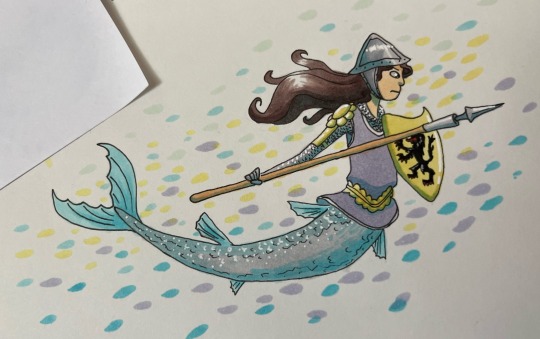
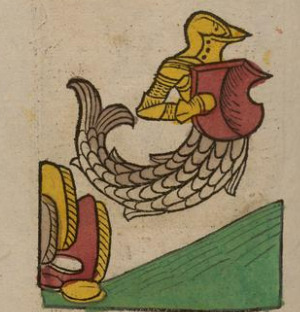
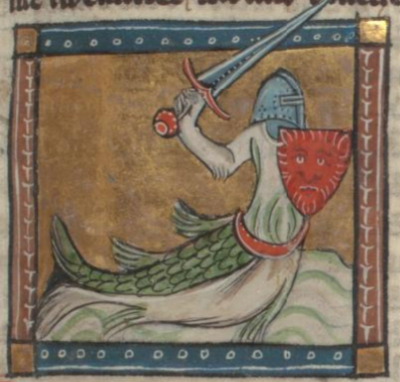
Zitiron- a creature with the bottom half of a fish and the top half of a knight.
The zitiron only shows up in three sources that I can find- the Ortus Sanitatis (published in Germany 1491, author unknown), Van der Naturen Bloeme (early 14th c) by Flemish poet Jacob van Maerlant, and De natura rerum (1244 CE) by Flemish writer Thomas of Cantimpré. Van der Naturen Bloeme is actually just a Dutch translation of the Latin De natura rerum, so technically there's only two original sources. The only reason I mention both is that the original De natura rerum- which is sourced from a large number of works by philosophers and writers such as Aristotle, Pliny the Elder, St. Ambrose, Jacques de Vitry, and too many others to explore them all as original sources- doesn't have any illustrations and is in Latin, which I can't read, making it a personally useless source. But Van der Naturen Bloeme does have illustrations- the third image in this post is Jacob van Maerlant's interpretation of the zitiron I assume to be outlined in De natura rerum.
The only other original place that a zitiron can be found, according to the internet, is in the Ortus Sanitatis, a Latin natural history encyclopedia with no known author published in 1491 in Mainz, Germany. It has illustrations, the second image in this post is the author's interpretation. But again, I can't read Latin and it's hard to read the stylized text to put into google translate.
There is almost no information about the zitiron online, which is a shame because it's a really interesting figure. If you can read Latin or medieval Dutch I would LOVE to work together to place the origin of this mythological creature and learn more about it!
For the drawing, I wanted to honor Jacob van Maerlant and Thomas of Cantimpré's Flemish heritage. The helmet, chainmail, shield, and goedendag on the zitiron are representative of what the Flemish forces wore and used at the Battle of the Golden Spurs, a 1302 victory of the French that is a source of pride and celebrated every July 11th by the Flemish today.
TLDR: The zitiron is a little known creature from the Middle Ages or perhaps antiquity, with the bottom half of a fish and the top half of a knight. My drawing is inspired by the Flemish culture of two of the only writers to leave any information about the zitiron.
If you've got the time and can read Latin, could you take a look at the two Latin texts I mentioned? For the Ortus Sanitatis, I was able to flip through the whole thing and find the page that has the info on zitirons. It's on page 730 here- (x). But for De natura rerum, which you can access here (x), I have no idea where it could be. There's a translation project for it ongoing through Kalamazoo College, but I don't see anything relating to zitirons or relevant mythology on their page so far. And if you can miraculously read medieval Dutch, here's the link to the page on zitirons in Van der Naturen Bloeme (x).
228 notes
·
View notes
Text
For March 1st, #lobsterinvasion, here is the lobster (locusta maris, sea locust) in the Liber de natura rerum.

Looks just like it.
#lobsters#lobster invasion#liber de natura rerum#thomas de cantimpre#fibsh#lobter invasion march1#lobter invasion
827 notes
·
View notes
Text






blemmyes et al.
illustrations of legendary peoples from a manuscript of thomas of cantimpré's liber de natura rerum, flanders, c. 1492
source: Ghent, St. Bavo's Cathedral, MS No. 15, fol. 2r and 2v
#15th century#thomas of cantimpré#liber de natura rerum#blemmyes#monopods#wild people#wundervölker#monstrous races#medieval art#illuminated manuscript
384 notes
·
View notes
Text
what ancient poetry book/anthology should i get into next
#there's so much i could read#namely and first off: the georgicon liber#which i still haven't read and it's the only vergil thing i haven't read and/or obsessed over#now that i've read the bucolicon liber like. scientifically#i could actually appreciate it#same thing goes for the de rerum natura#ooooooor maybe i could finally finish lucan#or start to dig into homer which is something that i've never really done#or maybe the elegiacs.... sexy#i should also delve into greek poetry more.
3 notes
·
View notes
Text
The end notes for The Probable Stars are too long to makes sense having on AO3, so I’m including them here.

NB:
• Claudius Ptolemy: 2nd-century Greco-Roman mathematician, astronomer, geographer and astrologer. Tetrabiblos was a foundational text on astrology for more than a thousand years.
• Robert Grosseteste: a 13th-century English scholastic philosopher, theologian and scientist who wrote De sphera on astronomy and De luce on cosmogony.
• Robert of Chester: a 12th-century Arabist who translated the first book on alchemy to reach Europe, Liber de compositione alchimiae.
• Jabir ibn Hayyan: a 8th-century Islamic chemist and alchemist, astronomer and astrologer, among many other things. Matthew is apparently unconcerned with the pseudo-Geber controversy. (Does he have the inside scoop?)
• Sidereus Nuncius: Starry Messenger by Galileo. The first published scientific work based on observations made through a telescope. It's a lovely design artifact, as well.
• On the Nature of Things: De rerum natura by the 1st-century BC Roman poet and philosopher Lucretius. Alma Venus, caeli subter labentia signa. The manuscript was rediscovery in a German monastery by Poggio Bracciolini in 1417. (I assume Matthew was team Valla in the very public Bracciolini-Valla feud. Did Niccolo de Niccoli hook Matthew up with De rerum natura during his decade-and-a-half “borrowing” of the manuscript from Bracciolini? And, wow, Matthew would have fit in so well amongst this bunch of early renaissance obsessive drama queens.)
• ni muer ni viu ni no guaris: from Quant l'aura doussa s'amarzis by Cercamon, a 12th-century troubadour who composed in Old Occitan and is credited with inventing the Provençal dirge.
• The title of this fic comes from You are tired, (I think) by E. E. Cummings, which includes this amazing stanza:
You have played,
(I think)
And broke the toys you were fondest of,
And are a little tired now;
Tired of things that break, and—
Just tired.
13 notes
·
View notes
Text
Praise to Epicurus

"For if we must speak as the acknowledged grandeur of the things itself demands, a god he was, a god, most noble Memmius, who first found out that plan of life which is now termed wisdom, and who by trained skill rescued life from such great billows and such thick darkness and moored it in so perfect a calm and in so brilliant a light.
13 Compare the godlike discoveries of others in old times: Ceres is famed to have pointed out to mortals corn, and Liber the vine-born juice of the grape; though life might well have subsisted without these things, as we are told some nations even now live without them.
18 But a happy life was not possible without a clean breast; wherefore with more reason this man is deemed by us a god, from whom come those sweet solaces of existence which even now are distributed over great nations and gently soothe men’s minds.
But unless the breast is cleared, what battles and dangers must then find their way into us in our own despite! What poignant cares inspired by lust then rend the distressful man, and then also what mighty fears! And pride, filthy lust and wantonness? What disasters they occasion! And luxury and all sorts of sloth?
49 He therefore who shall have subdued all these and banished them from the mind by words, not arms, shall he not have a just title to be ranked among the gods?
52 And all the more so that he was wont to deliver many precepts in beautiful and god-like phrase about the immortal gods themselves and to open up by his teachings all the nature of things."
From Book V of De Rerum Natura by Lucretius
#epicurean#epicurus#epicureanism#epicurean theology#greek philosophy#roman philosophy#lucretius#de rerum natura
1 note
·
View note
Photo

wild unicorn
Thomas of Cantimpré, Liber de natura rerum, France ca. 1290
Valenciennes, Bibliothèque municipale, ms. 320, fol. 71r
#unicorn#monoceros#bestiary#animals#medieval#art#medieval art#middle ages#13th century#book#manuscript
724 notes
·
View notes
Note
Here’s some more vintage squids! (sticking to squids, octopuses are a different kettle of cephalopods)

The squid from Thomas de Cantimpré’s Liber de Natura Rerum. It flies like an arrow, so it has avian features!

The squid from the Ortus Sanitatis is… Literally A Fish.


The nameless “horrible monster” described by Olaus Magnus, with its profusion of horns, is believed to an early description of the kraken, and thus a giant squid!
As for the sea monk? Steenstrup popularized the “giant squid” interpretation, but on the balance of the evidence it is more likely that it was an angel shark (aka… monkfish). The weird appearance came about by a game of telephone and artists who took descriptions rather literally.

Different representations of the sea monk and possible suspects from Paxton and Holland (2005) Was Steenstrup Right? A New Interpretation of the 16th Century Sea Monk of the Øresund, which summarizes the facts.
I know that medieval art has some fun depictions of various animals. Are there any fun depictions of squid (or similar creatures) in old-timey art that you know of and would like to share (either from medieval art or another time period)?
YES, I have a couple
One is the depiction of a Sea Monk , there's a squid in there (but it looks pretty damn good honestly!)
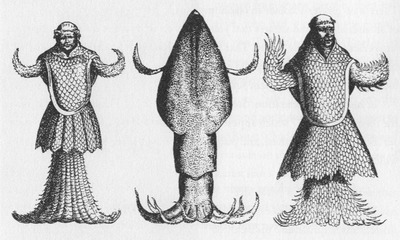
and then my other favorite is from a drawing of a "giant squid" that washed up on an Irish beach
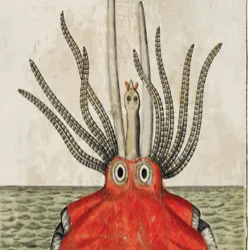
Illustration of “monster” washed ashore in Dingle Bay, 1672
189 notes
·
View notes